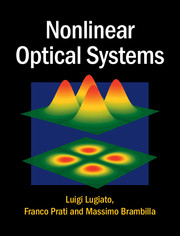Book contents
- Frontmatter
- Dedication
- Contents
- Preface
- Part I Models, propagation, stationary phenomena
- Part II Dynamical Phenomena, Instabilities, Chaos
- 18 Some general aspects in nonlinear dissipative dynamical systems
- 19 Special limits in the single-mode model
- 20 The linear-stability analysis of the Maxwell–Bloch equations
- 21 Adiabatic elimination in the complete Maxwell–Bloch equations
- 22 Dynamical aspects in the laser
- 23 Single-mode and multimode operation in inhomogeneously broadened lasers
- 24 Dynamical aspects in optical bistability
- 25 Self-pulsing in other optical systems
- Part III Transverse optical patterns
- Appendix A The Routh–Hurwitz stability criterion
- Appendix B Calculation of the oscillatory instability boundary
- Appendix C Coefficients of the characteristic equation (20.20)
- Appendix D Derivation of equations (20.27) and (20.28)
- Appendix E Coefficients of equations (20.60) and (20.61)
- Appendix F The exact boundary of the Risken–Nummedal–Graham–Haken instability
- Appendix G Nonlinear analysis of the roll solution
- References
- Index
20 - The linear-stability analysis of the Maxwell–Bloch equations
from Part II - Dynamical Phenomena, Instabilities, Chaos
Published online by Cambridge University Press: 05 March 2015
- Frontmatter
- Dedication
- Contents
- Preface
- Part I Models, propagation, stationary phenomena
- Part II Dynamical Phenomena, Instabilities, Chaos
- 18 Some general aspects in nonlinear dissipative dynamical systems
- 19 Special limits in the single-mode model
- 20 The linear-stability analysis of the Maxwell–Bloch equations
- 21 Adiabatic elimination in the complete Maxwell–Bloch equations
- 22 Dynamical aspects in the laser
- 23 Single-mode and multimode operation in inhomogeneously broadened lasers
- 24 Dynamical aspects in optical bistability
- 25 Self-pulsing in other optical systems
- Part III Transverse optical patterns
- Appendix A The Routh–Hurwitz stability criterion
- Appendix B Calculation of the oscillatory instability boundary
- Appendix C Coefficients of the characteristic equation (20.20)
- Appendix D Derivation of equations (20.27) and (20.28)
- Appendix E Coefficients of equations (20.60) and (20.61)
- Appendix F The exact boundary of the Risken–Nummedal–Graham–Haken instability
- Appendix G Nonlinear analysis of the roll solution
- References
- Index
Summary
In this chapter we outline the general scenario for optical temporal instabilities, starting from the standard Maxwell–Bloch equations. With the exception of Section 22.7, in Part II we will always consider the ring-cavity configuration because only in the case of the ultrathin-medium case considered in Section 22.7 is the treatment of instabilities in Fabry–Perot cavities not substantially more complicated than that in the ring-cavity configuration.
Some authors have introduced special approaches in order to study temporal optical instabilities, exploiting the concepts of gain and of dispersion, which are natural in optical systems and therefore help our intuition. In particular, a hint of the mechanism that produces instabilities in optical systems is offered by the so-called “weak-sideband” approach or “gain-feedback approach” [245–249], whose validity can be justified rigorously with the help of the linear-stability analysis [250]. The central point of this method is the response of the system to a weak probe passing through a collection of two-level atoms driven by a strong field [251–253]. If the strong signal with carrier frequency ω0 saturates the medium, we can find regions of the frequency axis, which are far removed from the carrier frequency of the signal, where the weak probe can experience gain instead of absorption even if the medium has no population inversion.
In this book we follow the approach of [250], which is rigorously rooted in the linear- stability analysis and, in addition, establishes a general, useful and, in a sense, surprising connection between single-mode and multimode instabilities. We classify as single-mode a temporal instability that involves the resonant mode only, and classify as multimode a temporal instability that involves only off-resonance cavity modes. The discussion in this chapter is mainly focussed on this connection.
In Section 20.1 the multimodal equations derived in Section 12.2 are reformulated by introducing a modal expansion also for the atomic variables. In this way one obtains a complex hierarchy of equations that couple the modal amplitudes for the field and for the atomic variables.
- Type
- Chapter
- Information
- Nonlinear Optical Systems , pp. 233 - 246Publisher: Cambridge University PressPrint publication year: 2015

